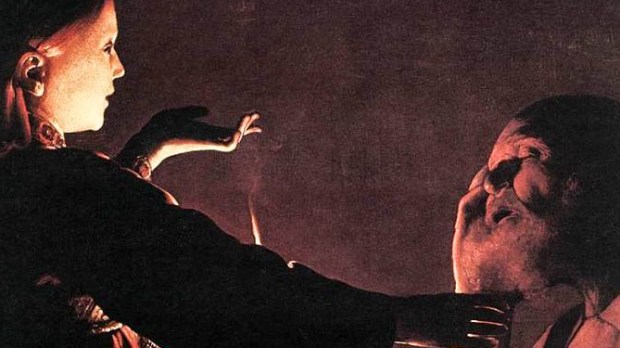It was indeed a tough day for Joseph. After his labor at the carpenters table, he had discovered with deep sorrow that Mary, his betrothed, was pregnant. As the tongues in the town wagged furiously with the news, Joseph was deeply embarrassed, as only he knew that he was not the father.
He was well aware of the gruesome punishment and the disgrace that would await Mary if she was prosecuted for adultery. His delicate feelings decided otherwise. Despite his painful discovery and his ignorance of the divine incarnation plan, he resolved not to defame his affianced but rather to divorce her privately, avoiding a messy public trial.
As the sun goes down the horizon, a night of anguish and introspection invades Joseph. After the bustle of the day, he desired the inner silence of the night. As thoughts stormed his mind, he lay down at rest in his armchair, seeking some refuge.
Georges de la Tour takes this dramatic scene to the next level. Gone is the Italian architecture and the Dutch landscape. The nature of the canvas takes us far from the outwardly or the human point of view, dwelling rather deep on the intimate, more inner nature of man. The room is devoid of cluttering details. It exemplifies the essentials (i.e., two protagonists and the play of divine light).
Deep silence permeates the room. The silence lulls Joseph into a sagely slumber. The flame of the consuming candle soon finds company in divine radiance. In comes an immaculate mediator from God. Face aglow, eyes focused, the left hand of the angel moves in parallel with Joseph’s consciousness.
The outstretched right arm of the angel protectively shields the flame. This prevents the effulgent gleam from traversing into our space. It was a personal, private encounter. But how profound was this divine encounter for Joseph, that thanks to this dream he joins Mary in saying “yes” to God’s plan of action; yes to the history of salvation!
Joseph’s peaceful face is beheld by the enlightening glance of the angel who transmits this earthly passenger into a celestial sphere. As Joseph supports his head with his right hand, his left hand daintily holds on to the corner of the book. It symbolizes Joseph’s holding on to God’s word revealed to him in the dream in faith; a faith that leads to action.
In this fascinating work of art, Georges de la Tour employs “tenebrism” in order to bring alive a nocturnal scene. The word tenebrism is derived from the Italian term tenebroso, meaning dark, gloomy, rather mysterious. It is a technique to create drama through a spotlight effect. He uses chiaroscuro, contrasting light and darkness, so as to conceive a sense of depth in the canvas. The “Dream of Joseph” was completed by La Tour in 1640. Currently, it is on exhibit at the Musee des Beaux-Arts in Nantes, France.
Joynel Fernandes is the Assistant Director of the Archdiocesan Heritage Museum, Mumbai, India. She is currently pursuing her Masters in History. Researching on Church History and Church art is her passion. She hopes to make its understanding more approachable to younger generations.
This article has been kindly granted to Aleteia by our partners in India, Indian Catholic Matters. We encourage you to visit their full website, here.

